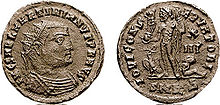- Sextus Martinianus
-
Sextus Marcius Martinianus (Martinian) Emperor of the Roman Empire 
Follis of MartinianusReign July – September 18, 324 (nominally as Augustus in the west, with Licinius as Augustus in the east) Died 325 Place of death Cappadocia, Pontus Predecessor Constantine I Successor Constantine I Sextus Marcius Martinianus (usually rendered in English as Martinian; died 325) was Roman Emperor from July to September 18, 324. He had been appointed co-emperor by Licinius.
Contents
Elevation
In 324, as the second civil war between Licinius and Constantine I was at its height, the situation for Licinius was not promising. Following his defeat at the Battle of Adrianople, he decided to replace Constantine (in name only) as western Augustus. As his replacement he named Martinian co-emperor, as he had previously appointed Valens[1] during his earlier war with Constantine. Prior to his elevation, which took place some time after the Battle of Adrianople (July 3, 324), Martinian was serving as magister officiorum at Licinius' court.[2]
Military activities
In the wake of Licinius's defeat at Adrianople Licinius sent Martinian, with an army including Visigothic auxiliaries,[3] to Lampsacus (on the Asiatic shore of the Hellespont or Dardanelles) to prevent Constantine from crossing from Thrace into Mysia and Bithynia in Asia Minor.[4] A naval battle in the Hellespont resulted in the destruction of Licinius' navy by Constantine's eldest son Crispus.[5] Following this defeat Licinius withdrew his forces from Byzantium, which was being besieged by Constantine, to Chalcedon on the Asiatic shore of the Bosphoros. Constantine then crossed over to Asia Minor, using a flotilla of light transports in order to evade the forces of Martinian.[6] Licinius recalled Martinian from Lampsacus to reinforce his main army.[7][8] On September 18 Licinius was defeated for the last time at the Battle of Chrysopolis.[9]
Fate
Due to the intervention of Flavia Julia Constantia, Constantine's sister and also Licinius' wife, both Licinius and Martinian were initially spared, Licinius being imprisoned in Thessalonica, Martinian in Cappadocia; however, Constantine seems to have soon regretted his leniency as Martinian was subsequently executed, probably in the spring of 325,[10] in Cappadocia.[11]
Notes
- ^ Grant (1993), pp. 42–43. Gaius Aurelius Valerius Valens was raised by Licinius to the position of Augustus in 316, following his defeat Licinius appeased Constantine by deposing and executing Valens.
- ^ Jones, pg. 563
- ^ Grant (1993), p. 57
- ^ Canduci, pg. 126
- ^ DiMaio, Michael, "Licinius (308 – 324 A.D.)"
- ^ Grant (1985), p. 236
- ^ Grant (1993), pp. 46–47
- ^ Odahl, p. 180
- ^ DiMaio, Michael, "Martinianus (324 A.D.)"
- ^ Grant (1993), pp. 47–48
- ^ Canduci, pg. 126
References
- DiMaio, Michael, "Martinianus (324 A.D.)", DIR (1996).
- DiMaio, Michael, "Licinius (308 – 324 A.D.)", DIR (1997).
- Jones, A.H.M., Martindale, J.R. The Prosopography of the Later Roman Empire, Vol. I: AD260-395, Cambridge University Press, 1971
- Grant, Michael (1985), The Roman Emperors: A biographical Guide to the Rulers of Imperial Rome 31 BC-AD 476, London. ISBN 0-297-78555-9
- Canduci, Alexander (2010), Triumph & Tragedy: The Rise and Fall of Rome's Immortal Emperors, Pier 9, ISBN 978-1741965988
- Grant, Michael (1993), The Emperor Constantine, London. ISBN 0-7538-0528-6
- Odahl, C.M., (2004) Constantine and the Christian Empire, Routledge 2004. ISBN 0-415-17485-6
Regnal titles Preceded by
LiciniusRoman Emperor
324
Served alongside: LiciniusSucceeded by
Constantine ICategories:- 325 deaths
- 325 crimes
- Executed Roman emperors
- 4th-century Roman emperors
- Magistri officiorum
Wikimedia Foundation. 2010.
